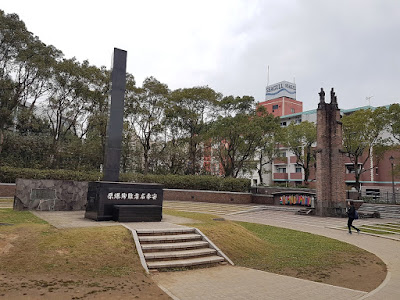JPN: Hypocenter Park & Peace Park
[Hypocenter Park]
5 Matsuyamamachi, Nagasaki, Japan
The atomic bombings of Hiroshima and Nagasaki: many of us have probably heard about it from our History class. On 9 August 1945, the USA dropped a plutonium implosion bomb nicknamed "Fat Man" at the place which is now known as Hypocenter Park in Nagasaki. Not far from it is Peace Park that was established 10 years later to commemorate the grievous event.
JPN: Huis Ten Bosch (Part 1)
JPN: Huis Ten Bosch (Part 2)
JPN: APA Hotel Nagasaki Ekimae
JPN: Nagasaki Ropeway
JPN: Mount Inasa
JPN: Hypocenter Park & Peace Park <YOU ARE HERE!>
JPN: Champon Museum
JPN: Nagasaki Chinatown
JPN: Nagasaki Downtown
JPN: Nagasaki Airport
JPN: Skymark Airlines BC148 (Economy)
To reach the Hypocenter Park, my BFFs and I took a tram to Atomic Bomb Museum station.


You can see remnants of the Urakami branch of Nagasaki Prison, which was the closest public building to the hypocenter.
May I pray that we put aside our differences and hatred towards one another? Let's forgive and move on to build a better world for the present and the future.
5 Matsuyamamachi, Nagasaki, Japan
The atomic bombings of Hiroshima and Nagasaki: many of us have probably heard about it from our History class. On 9 August 1945, the USA dropped a plutonium implosion bomb nicknamed "Fat Man" at the place which is now known as Hypocenter Park in Nagasaki. Not far from it is Peace Park that was established 10 years later to commemorate the grievous event.
---
JPN: Huis Ten Bosch (Part 1)
JPN: Huis Ten Bosch (Part 2)
JPN: APA Hotel Nagasaki Ekimae
JPN: Nagasaki Ropeway
JPN: Mount Inasa
JPN: Hypocenter Park & Peace Park <YOU ARE HERE!>
JPN: Champon Museum
JPN: Nagasaki Chinatown
JPN: Nagasaki Downtown
JPN: Nagasaki Airport
JPN: Skymark Airlines BC148 (Economy)
JPN: Kobe City Hall Observation Deck
JPN: Meriken Park
JPN: Nankinmachi
JPN: Kobe Anpanman Children’s Museum and Mall
JPN: Kobe Oji Zoo (Part 1)
JPN: Kobe Oji Zoo (Part 2)
JPN: Rokko Cable Car
JPN: Mount Rokko
JPN: Kobe Luminarie 2019
JPN: Kobe Downtown
JPN: Hasegawa Rinku Guest House West
JPN: Kansai International Airport
JPN: Meriken Park
JPN: Nankinmachi
JPN: Kobe Anpanman Children’s Museum and Mall
JPN: Kobe Oji Zoo (Part 1)
JPN: Kobe Oji Zoo (Part 2)
JPN: Rokko Cable Car
JPN: Mount Rokko
JPN: Kobe Luminarie 2019
JPN: Kobe Downtown
JPN: Hasegawa Rinku Guest House West
JPN: Kansai International Airport
---
To reach the Hypocenter Park, my BFFs and I took a tram to Atomic Bomb Museum station.
About one-third of the city was ravaged by the atomic bomb. The hypocenter of the explosion is marked by a cenotaph that was erected in 1968.
 |
| Over 70,000 people were killed and many more were injured in the incident. |

 |
| That was the first structure planted to mark the hypocenter. |
The hypocenter remains as an international peace park today, serving as a symbol of the aspiration for world harmony.
 |
| Let's stop all kinds of wars. |
The area within 2.5 km radius of the hypocenter was obliterated, and at that time, it was predicted that the area would be devoid of vegetation for 75 years. However, one month later, about 30 kinds of plants started to grow again, signifying the power of revival. Today, there are about 500 cherry blossom trees at the park.
We went down to see a segment of the preserved ground after the atomic bombing.
 |
| Such devastation... |

 |
| Could you imagine the blast wind and heat rays of several thousand degree Celsius? |
Before going over to Peace Park, we made a brief stop at the nearby Nagasaki Atomic Bomb Museum.
 |
| What a poignant image... |
Here are the opening hours of the museum.
- Sep-Apr: 8.30am - 5.30pm
- May-Aug: 8.30am - 6.30pm
- 7-9 Aug: 8.30am - 8.00pm
 |
| The adult entrance ticket costs ¥200 (~S$2.65), while a student fare is half of that. |
 |
| I wasn't expecting that Wi-Fi password at all. |
[Peace Park]
9 Matsuyamamachi, Nagasaki, Japan
We entered Peace Park not from the main walkway, but from one of the eastern paths.
 |
| Bell of Nagasaki is one of the surviving bells of the nearby Urakami Cathedral, under which you can meet a survivor of the atomic bombing. |
The defining feature of the park is the Peace Statue at the northern end of the park sculpted by Seibo Kitamura.
 |
| The right hand points to the threat of nuclear weapons, while the extended left hand symbolises eternal peace. |
In 1978, the city invited donations of monuments from countries around the world.
 |
| A celebration of life! |
Gifted by Australia, Tree of Life is a monument that particularly caught my eyes. Accompanying the monument is a description in three languages: Japanese, English and an Australian aboriginal language.
Fountain of Peace is located at the southern end of the park, which was constructed in 1969 as a prayer for the repose of the souls of many of the victims who died searching for water.
 |
| "I was thirsty beyond endurance. There was something oily on the surface of the water, but I wanted water so badly that I drank it just as it was." |
We left the park via the main walkway.






























Comments
Post a Comment